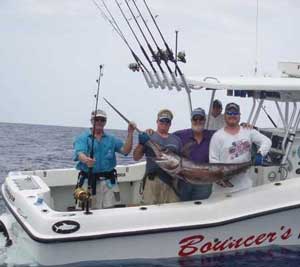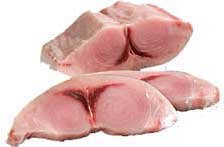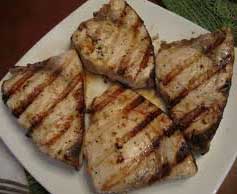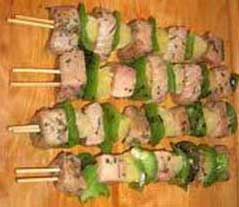Swordfishing in Florida
Swordfishing is not for the timid. This magnificent creature that lives 30 years
and can reach 1,200 lbs at 14 feet long lurks in the deep waters of the Gulf Stream
offering lucky anglers a brutal fight and trophy size fish. And they are excellent eating. Once hooked this aggressive Billfish are known to shoot straight out of the water from a depth of 500 feet in an instant then dive straight back down to the same depth offering one of the most exciting catches of your life. The Swordfish is one of the fastest swimmers ? 60 mph sprints are very common.
 |
| Photo Courtesy of Captain Bouncer Smith of Bouncers Dusky 33, Miami Beach with a 545 lb. Swordfish |
Swordfish in Florida
Swordfish are found worldwide in all temperate, subtropical and tropical seas, Florida is known to be a Swordfish breeding grounds. Swordfish are classified as High Migratory Species along with Atlantic Tunas, Sharks, Swordfish and Billfish and require a permit to catch & keep one. Swordfish are not schooling fish but have been found in very loose groups. Occasionally they can be found basking in the sun at the surface or seen performing magnificant aerial leaps beleived to be an act of trying to rid themselves of pests and parasites.
Swordfish prefer the cold waters of the canyons and valley of very deep water in the 1,500+ foot range and have been found in water temperatures from 41?F (5?C ) to 81?F (27?C). Swordfish spend there days foraging the bottoms then in the cover of night they will swim up to 500 feet or less and hunt for prey hence the reason most anglers will fish for Swordfish at night. The actual sword is not used to stab prey, it is used to stun the prey by striking it and then the Sword will use it's powerful speed to immobilize the prey. With smaller prey the Sword will swollow them whole. This large predator has few enemies, only large sharks such as the Mako will dare to tackle the giant Swordfish.
Swordfish grounds are in the 1,000 to 1,500 foot depths in the middle of the Gulf Stream and Straights of Florida and catching a Sword is a year round sport in Florida. The best Swordfish grounds in Florida are from Jupiter Inlet all the way down to Key West. During the day Swordfish stay on the bottom requiring a lot of line and patience. Swordfish are opportunistic feeders that forage from the bottom to the surface over great depths and distances on Mackerel, Squid Barracuda, Redfish and Filefish.
Finding structure where the strong currents create an upwelling of nutrients and bait is where you need to be. Look for hills and valleys on your bottom finder. Drop bait using several lines at varying depths and drifting with the 4 knot Gulf Stream on a northerly crawl using a Drogues (sea anchor) is the best method. The Drougues will slow your boat down in the swift current and help keep your boat at a right angle to the current. Due to the great depths of the Swordfish grounds anchoring is impossible plus this fish is always on the move.
To give you an idea of where the Swordfish are in Florida, look at this chart of commercial landings for 2011.
Tackle and Gear
 |
| Photo Courtesy of Bouncers Dusky 33, Miami Beach |
To catch a Swordfish you need a big boat and gear to match if you plan on landing a big one ? 80 lb test on trolling reels with heavy trolling rods, and downriggers or breakaway weights to get your bait down to the fish. Big 9/0 J-hooks tied to 12 foot 300 lb test mono leader tied to 80-pound mono line is a great setup for success. If fishing at night a plastic glow stick is attached to your leader to attract both bait fish and your prey. Attaching safety lines to your rods is a good idea to prevent the powerful Swordfish from ripping in from the boat on his powerful dives and areial leaps.
Setting out a chum line helps to attract bait fish which in turn attract the Swords. Live and dead baits can be used to attract the Swordfish such as Mullet, Herring, Bonito, Goggle-Eyes (Bigeye Scad), Mackerel, Squid, Eels and Deepwater Hake.
 |
| Photo Courtesy of Bouncers Dusky 33, Miami Beach |
Landing a Big One
Landing the fish is exciting and very dangerous, they have been reported to attack men, boats, whales and submersibles. This powerful fish can ram your boat and stab you with it's powerful sword. Thick gloves and long gaffs are a necessity. Using a flying gaff or harpoon to land large Swords helps a lot. Tie off your landing gaff or harpoon to a large poly ball or a cleat for easy retrieval after landing.
This video shows the landing of possibly the largest Swordfish ever caught during the daytime off the Florida Keys in March 2012 at 520 lbs. Catching a Swordfish of this size during daylight hours is rare due to the fact that Swords stay on the bottom in very deep water during the day.
Regulations
You need a Permit to catch a Swordfish. For federal waters out 200 miles Swordfish are managed by the Highly Migratory Division of the National Marine Fisheries Service. All owners/operators of vessels fishing recreationally for and/or retaining regulated Atlantic Highly Migratory Species (Atlantic tunas, sharks, swordfish and billfish) in the Atlantic Ocean, including the Gulf of Mexico and Caribbean Sea, must obtain an Atlantic Highly Migratory Species (HMS) permit.
- The bag limit is 1 per person, up to 4 per vessel per trip and there is no closed season.
- Swordfish must be caught with hook and line and downriggers are allowed.
- Swordfish may be headed and gutted at sea. Swordfish with the head attached will be measured using LJFL. Swordfish with the head removed will be measured using CFL. Size limits apply to fish damaged by Shark bites.
- 47" lower jaw FL with head attached or 29" cleithrum to keel length if head removed, or 33 pounds dressed
- All non-tournament recreational swordfish landings must be reported to NMFS within 24 hours either online at www.hmspermits.gov or by calling (800) 894-5528.
Read the complete set of rules on fishing Highly Migratory Species.
Steaking
 Since the Swordfish is such a large fish, the best way to fillet this fish is by "steaking". See our Keeping Your Catch page for tips and methods of Steaking.
Since the Swordfish is such a large fish, the best way to fillet this fish is by "steaking". See our Keeping Your Catch page for tips and methods of Steaking.
Swordfish, store bought or freshly caught, are one of the best tasting fish and very versatile. The meat should not be over-cooked or it will become dry and tough, one reason many people don't like it because they don't cook it correctly. Medium rare should be your goal; remember the steak will continue to cook when removed from the heat source.
 Grilled Swordfish Steaks
Grilled Swordfish Steaks
Swordfish is excellent on the grill and the meat is so firm that chunks on a skewer with vegetables is an excellent alternative to big steak slabs.
- Swordfish Steaks
- Oil
- Pepper
- Fresh Lemon Wedges
Wash and pat dry the Swordfish steaks. Coat each steak with oil on both sides then sprinkle with pepper (fresh ground pepper is best). Place each steak on a preheated hot grill and cook each side like you would a steak, approximately 5 minutes each side. Serve with fresh lemon wedges.
 Swordfish Kabobs
Swordfish Kabobs
- 1 1/2 pounds Swordfish cut into 1 to 2 inch chunks
- 1/2 Cup Vegetable Oil
- 1/4 Cup Lemon Juice
- 1/2 tsp Dry Oregano Leaves
- Pepper, fresh ground
- 8 12" Wooden Skewers
- Large Onion, red or white
- Large Pepper, red, green or yellow
- Zucchini cut into 1" chunks (optional)
- Mushrooms (optional)
- Cherry Tomatoes (optional)
Place skewers in a pan with water to soak so they do not burn on the grill. Remove the skin from the Swordfish and cut into same sized chunks. In a bowl mix oil, lemon juice, and spices then add the fish. Marinate fish in the refrigerator for 2 to 3 hours.
Cut up onion, zucchini, and green pepper into 1 inch chunks. Wash mushrooms and pat dry. Assemble your skewers alternating vegetables with the meat. Be sure to leave about 2" on each end so you can grip the kabobs during cooking. Reserve the marinate.
Place foil on the grill, spray with cooking spray, then put your kabobs on top. Coat the kabobs with the reserved marinate and cook 15 minutes turning several times to promote even cooking. You can also cook them on an oiled grill but you must turn them frequently to keep them from sticking and falling apart.
Serves 4 - you can easily double this recipe and use other vegetables. Serve with rice and salad.
Pan-seared Atlantic Swordfish Steaks With Fresh Tomato Relish
This video is a treat! Not only do you get the guys from How to Do Florida cooking but you also get to see them catch the fish at the beginning of the video of Islamorada.
- 4 6 oz. Swordfish Steaks
- Olive Oil
- Wheat Flour (or White Flour)
- 1 Fresh Lemon, juiced
- Capers
- Garlic, finely chopped
- Fresh Basil
- Fresh Parley
- Sea Salt and Fresh Ground Pepper
- 1 pint Cherry Tomatoes, quartered
- Extra Virgin Olive Oil
Preheat non-stick pan with olive oil to medium high. Wash and pat dry steaks. Dust each steak in flour, shake off excess then place in preheated pan. Pan sear fish steaks 2 to 3 minutes per side. While steaks are cooking mix all relish ingredients in a bowl coating with olive oil. Remove the cooked Swordfish steaks to a platter then scoop the tomato relish over the steaks. Enjoy!










